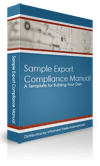DSP-73 Export License
What is a DSP-73 Export License?
Other than the DSP-5 Export License, the DSP-73 is the type of license I hear referenced most often in the export compliance community.
The purpose of a DSP-73 license is to allow for the temporary (not permanent) export of controlled goods regulated by the Department of State. This means that the items exported will be returning to the United States at some point in the future.
Articles exported under a DSP-73 license are subject to two primary criteria:
- The items being exported must return to the United States within a period of four years, and
- No transfer of title may take place during the period of export.
The first is pretty straightforward, but the second means that the US exporting party will still be responsible for the item returning to the US and for its use abroad. You can’t ship something overseas on a temporary export (DSP-73) license and sell it or give it away to a foreign national.
When would I use this?
I most often see the DSP-73 license come into play for overseas repairs. This means that a controlled item currently held in the US breaks and needs to be shipped out so it can be repaired. They’re sometimes used for shipping traveling exhibits, demonstrations and sometimes product samples. For technical data, the Technical Assistance Agreement is more flexible.
Note: If you’re using the DSP-73 temporary export license for overseas repairs, be aware that there is an exemption for repairs under 22 CFR 123.4(a)(1) which is much easier to utilize – provided the USML goods are of US manufacture. Foreign made goods, however, should definitely be sent for repair under the DSP-73.
Any procedures I should be aware of?
DSP-73 export licenses need to be endorsed by a Customs port director on both export and import. This is normally accomplished on the back of the actual license. Do be careful with shipments being continually exported and returned. It sounds silly, but since the original license is required and the paper is passed around constantly I’ve seen them actually wear out! This doesn’t sound like a big deal until you have to call the Department of State to get another copy…
Here are a couple of scenarios to be aware of when presenting the DSP-73 temporary export license to Customs & Border Patrol for endorsement on exit and entry:
- The license is specific in quantity. Let’s say you have 10 “widgets” under line item 1 on your license and you are shipping all 10 out, but they are packed in 2 boxes. Your transport document (air waybill, bill of lading) will reflect a quantity of 2. Your shipping invoice will reflect a quantity of 10. We often see CBP officers referring to the transport document and recording the quantity from there. This creates an enormous problem upon re-entry, as you will be attempting to return 10 widgets and your license will have been endorsed to show only 2 have been exported. As part of your compliance program, ensure that the license endorsement is reviewed PRIOR to leaving the CBP office to ensure the endorsement is correct.
- CBP officers occasionally forget to notate whether their endorsement signifies an exit or an entry. Though the CBP officer should be referencing either the AES ITN/XTN (for exports) or the Customs entry number (for imports) they often simply place the airway bill number in the reference block and neglect to note whether the shipment was an export or an import. Again, using the 10 widget scenario, let’s say you exported 5, and they were noted as an export on the endorsement. Then you imported those same 5 but the endorsement didn’t clarify that it was an import. A month later you try to export all ten. If the second endorsement simply shows 5 widgets and an airway bill number, CBP can assume this was an export until you produce evidence to the contrary. This shouldn’t be too difficult, but it can cause unforeseen delays and expenses that can be easily avoided by ensuring the endorsement is properly recorded PRIOR to leaving the Customs office.
Lastly, don’t forget that once the license is expired or its terms are fulfilled it must be returned to the Directorate of Defense Trade Controls.
Posted on June 4th, 2008 by keeton
Filed under: ITAR


You used the example of 10 widgets and for the quantities to be endorsed correctly as either imported or exported however, what about the license dollar values for the widgets. Isn’t it also important that the dollar values are endorsed properly because if they’re not, how else can you balance the entries and the exits when you turn the license in to DDTC?
Hi Leah! The example provided is incomplete and doesn’t account for dollar values, but the same applies. The point is to be hyper-aware of the data being recorded by the CBP officer at the time of entry. If you have to justify yourself to the DoS months or years down the line, it will be very difficult to re-construct those entries.
My question is: I have an approved DSP-73 for the multiple export and inport an Electro-Optical system for demonstration purposes…….the DSP-73 is approved for four years…….I have only one system to export and inport……is there a requirement for me to identify to DOS how many times in the four years I will be exorting and inporting the system?
My questions are relating to temporary export of an ATF NFA registered item, a rifle sound suppressor specifically.
While ATF does not require the filing of their 5320.20 form for transportation within CONUS of sound suppressors is a DSP-73 required for the temporary export and subsequent return for an item of this type?
Thank you.
my question are about the one old navy amphibio plane grumman -hu16c year 1953 ,reverted since 2003 in privite planein usa.
i need special military permition to export to brasil?
tks
What about when you want to hand-carry items (with your luggage) under a DSP-73 when you travel outside the country. What is the protocol?
My Question is; We have equipment that we need to support outside of the US. We manufactured the equipment. And now need to have repairs performed on some of it. Can we use the DSP-73 to send modules to our customer who then then replace the modules and return the failed componets to us?
As a defense contractor we will be shipping ship systems/parts (government furnished) overseas to the location of the ship. Will we need a DSP-73? And do we apply for that license or the government?